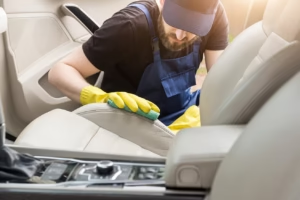Faded plastic trim and bumpers can make even a well-maintained car look tired and neglected. Over time, exposure to sunlight, rain, and road grime strips away the rich black or gray finish of these plastic parts, leaving them dull, chalky, or grayish-white. Replacing them is expensive and often unnecessary—luckily, you can restore them yourself using everyday household items or budget-friendly DIY techniques. In this 2000+ word guide, I’ll walk you through every step of assessing and reviving your car’s plastic trim and bumpers, with detailed explanations to make the process clear and approachable. By the end, you’ll have a revitalized exterior that looks sharp and lasts—all for a few bucks and a couple of hours of effort.
Why Plastic Trim and Bumpers Fade (and Why It’s Worth Fixing)
Plastic trim and bumpers—like side mirror caps, window seals, and bumper covers—are made from durable materials like polypropylene or ABS plastic. These parts often start with a factory finish (sometimes dyed, sometimes coated) that gives them a deep, uniform color. But years of UV rays oxidize the surface, breaking down the plastic’s oils and pigments, while weather and dirt etch in that faded, chalky look.
Restoring them matters because:
-
- Boosts Appearance: Shiny, dark trim makes your car look newer and cleaner—think of it as a mini facelift.
-
- Saves Money: New trim or bumpers cost $50–$500 each; this DIY fix is under $10 with stuff you might already own.
-
- Protects Longevity: Restoration seals the plastic, slowing future fade and cracking.
-
- Adds Value: A sharp exterior ups resale appeal—no one wants a beat-up-looking ride.
This guide focuses on faded but intact plastic—cracked or broken parts need replacement. With household hacks and a little elbow grease, you’ll see results that rival store-bought restorers. Let’s dive in!
Tools and Materials You’ll Need
You don’t need a pro detailing kit—just common items from your kitchen, garage, or a quick store run. Here’s a detailed list with explanations of why each works and how you’ll use it:
-
- Soap and Water: Dish soap (e.g., Dawn) and warm water clean off dirt and grease—key for a fresh start. A bucket and sponge get it done—$1 if you need soap.
-
- Microfiber Cloths or Rags: Soft and absorbent for washing, wiping, and applying restorers—won’t scratch plastic. Old T-shirts or a $5 microfiber pack work—grab 3–5.
-
- Masking Tape: Protects nearby paint from restorers or sanding—painter’s tape (blue, $3) sticks well and peels clean.
-
- Sandpaper (Wet/Dry): Fine grits (1000–2000) smooth rough, faded surfaces—optional for tough cases. A $5 variety pack from a hardware store is plenty.
-
- Water Spray Bottle: Keeps sandpaper wet and applies solutions—recycle an old bottle (rinse it) or buy for $1.
-
- Rubbing Alcohol: Cleans deep grime and preps plastic—70% isopropyl ($2 at a drugstore) wipes off grease fast.
-
- Household Restorers:
-
- Olive Oil or Vegetable Oil: Adds shine and darkens plastic—moisturizes the surface. Pantry staple—use a tablespoon.
-
- Peanut Butter: Oils and mild abrasion restore color—smooth, not crunchy ($2 jar).
-
- Vinegar: Cuts grease and lightens chalky fade—white vinegar ($1) works as a cleaner.
-
- Baking Soda: Mixed into a paste, it scrubs off oxidation—cheap and gentle (under $1).
-
- Household Restorers:
-
- Heat Gun or Hairdryer: Heats plastic to revive oils—optional but effective ($20 heat gun or use your dryer).
-
- Protectant: Locks in the fix—cooking spray (oil-based), Vaseline, or store-bought silicone spray ($5) seal it.
-
- Soft-Bristle Brush: Loosens dirt—an old toothbrush or dish scrubber (soft side) is perfect for crevices.
-
- Safety Gear: Gloves (keeps hands clean, $5 pack), safety glasses (dust protection, $3), and a mask (sanding or fumes, optional).
Optional Extras:
-
- Plastic Trim Restorer: Store-bought gel (e.g., Meguiar’s, $8) enhances results—combines with DIY hacks.
-
- Shop Towels: Disposable for messy oils—keeps rags reusable.
Cost? Under $10 with household stuff—beats $50+ for pro work or pricey restorers.
Preparation: Setting Up for Success
Before you start, prep your car and tools to avoid mess and ensure a smooth job:
-
- Park in a Shaded Spot: Sun dries solutions fast and fades plastic more—work in a garage, under a tree, or on a cloudy day. Good light helps you see fade clearly.
-
- Gather Your Supplies: Lay out everything—soapy water, rags, peanut butter, etc.—on a seat or nearby table. Check amounts: a few tablespoons of oil, a cup of vinegar, enough tape to outline trim. No running back inside mid-job.
-
- Check the Plastic: Look at your trim and bumpers—faded (gray/white) or just dirty? Rough or smooth? This guide fixes fade—cracks or gouges need repair first. Test methods on a small spot (e.g., under a bumper) if unsure.
-
- Wear Safety Gear: Slip on gloves—oils and vinegar get sticky or smelly. Glasses block sanding dust; a mask helps if heating plastic (fumes). Comfort keeps you rolling.
Step-by-Step Guide to Restoring Faded Plastic Trim and Bumpers
We’ll assess the fade first, then restore step-by-step. This works for exterior plastic trim (mirrors, window seals) and bumpers—adjust for size. Do one section at a time for focus.
Part 1: Assess the Fade
Know what you’re fixing:
Step 1: Inspect the Plastic
-
- Look Closely: Check trim and bumpers—grayish, chalky, or white patches mean UV fade. Dirty but dark? Might just need cleaning. Compare to unfaded spots (e.g., under a seal).
-
- Feel It: Run your hand over—rough or powdery? Deep oxidation. Smooth but dull? Surface fade—easier fix.
-
- What It Means: Light fade needs cleaners and oils; heavy fade might need sanding or heat—tailor your approach.
Part 2: Restore the Plastic
Here’s how to bring back that rich color:
Step 2: Clean the Plastic
-
- Mix and Wash: Fill a bucket with warm water and a squirt of dish soap—bubbles mean it’s ready. Dip a microfiber cloth or sponge and scrub the plastic—focus on grimy spots (road tar, dust). Takes 3–5 minutes per section.
-
- Rinse Off: Spray with a water bottle or hose—wash away soap and loose dirt. No residue—soap dulls restorers.
-
- Dry It: Wipe with a dry cloth—clean and dull is your baseline. Check for grease—repeat if sticky.
-
- Why It Matters: Dirt blocks restorers—clean plastic takes oils or heat better, showing truer color.
Step 3: Tape Off Surrounding Areas
-
- Protect Paint: Tear 12-inch strips of masking tape—stick along the plastic’s edge, overlapping onto paint by 1/4 inch. Press firm—cover nearby bodywork, glass, or chrome.
-
- Double Up: Add a second layer—oils smear, and sanding dust travels. A 1–2 inch border is safe.
-
- Why It Matters: Restorers like peanut butter or oil stain paint—tape keeps your car pristine.
Step 4: Sand Rough Fade (Optional)
-
- Wet Sand: For chalky, rough plastic, soak 1000-grit sandpaper in water—spray the trim too. Rub gently in circles—5 minutes per section—smooths oxidation. Step to 2000-grit for a finer finish—another 3 minutes.
-
- Rinse and Dry: Spray water to clear dust, wipe dry—should feel smoother, look even (still dull).
-
- Why It Matters: Sanding removes dead plastic—only for bad fade. Skip if smooth—oils alone might work.
Step 5: Apply a Household Restorer
-
- Pick Your Method:
-
- Olive Oil: Dab a tablespoon on a cloth—rub into plastic in circles, 3–5 minutes. Darkens and shines—wipes off excess.
-
- Peanut Butter: Scoop a teaspoon (smooth type), smear on with a cloth—rub 5 minutes. Oils darken; grit buffs. Wipe clean—greasy but effective.
-
- Vinegar Paste: Mix 2 tbsp baking soda and 1 tbsp vinegar into a paste—apply with a brush, let sit 10 minutes, scrub off. Lightens chalk, preps for oil.
-
- Pick Your Method:
-
- Work It In: Firm pressure—cover evenly. Plastic darkens as oils sink in or oxidation lifts.
-
- Why It Matters: Oils rehydrate plastic, mimicking its original sheen; vinegar/baking soda cleans deeper fade—kitchen magic.
Step 6: Wipe and Buff
-
- Clean Off: Dampen a cloth with water—wipe away excess oil or paste. Dry with a fresh cloth—should look darker, less chalky.
-
- Buff It: Rub with a dry microfiber—brings out shine, evens finish. Takes 2–3 minutes per section.
-
- Why It Matters: Excess goo attracts dust—clean and buff lock in the look.
Step 7: Heat Treatment (Optional)
-
- Apply Heat: Use a hairdryer (high) or heat gun (low, 6–8 inches away)—wave over plastic 2–3 minutes. Warms oils inside, reviving color—don’t melt it (keep moving).
-
- Cool Down: Let sit 5 minutes—check depth of black/gray.
-
- Why It Matters: Heat pulls natural oils to the surface—great for stubborn fade, no extra product needed.
Step 8: Seal the Plastic
-
- Add Protectant: Dab Vaseline or cooking spray on a cloth—wipe a thin layer over restored plastic. Or use silicone spray—light mist, wipe even. Let dry 10 minutes.
-
- Buff Again: Dry cloth—polish to a low sheen, no stickiness.
-
- Why It Matters: Seals block UV and water—fade stays away longer (months, not weeks).
Step 9: Final Check and Clean
-
- Peel Tape: Pull off slowly—no paint lift. Check edges—no oil on bodywork.
-
- Wipe Around: Damp cloth—clean stray restorer from paint or glass. Dry it.
-
- Why It Matters: Crisp lines finish the job—sloppy edges ruin the vibe.
Step 10: Test and Inspect
-
- Look Over: Step back—trim and bumpers should look dark, even, shiny. Compare to before—night-and-day difference?
-
- Weather Test: After a rain or week—still good? Re-seal if fading creeps back.
-
- Why It Matters: Confirms your fix works—durability’s the goal.
Tips for a Lasting Restore
-
- Start Small: Test on a mirror cap—perfect your method.
-
- Layer It: Sand, oil, then heat—stack techniques for tough fade.
-
- Maintain: Wipe with oil monthly—keeps shine alive.
-
- Cover Up: Park in shade or use a car cover—slows future fade.
Troubleshooting
-
- Still Faded: Rougher sanding (800-grit) or more heat—surface might be too far gone.
-
- Sticky Finish: Too much oil—wipe harder with alcohol, re-seal lightly.
-
- Color Uneven: Missed spots—reapply restorer, buff longer.




